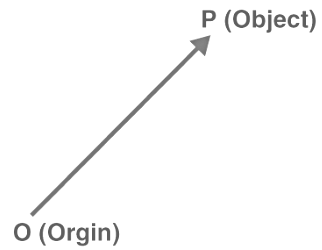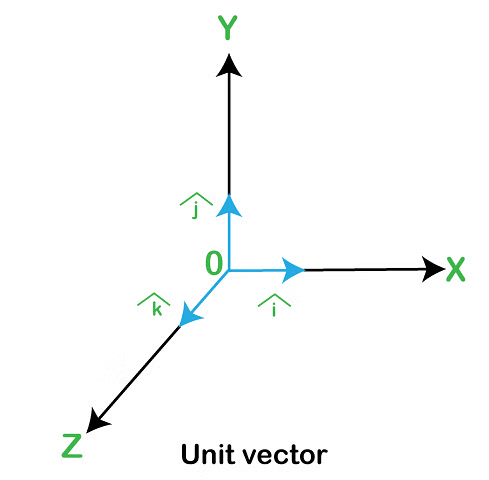Vectors: Definition, Types & Unit Vectors | Physics for JEE Main & Advanced PDF Download
| Table of contents |

|
| Scalar and Vector Quantities |

|
| Representation of a Vector |

|
| Types of Vectors |

|
| Unit Vector |

|
| Solved Example on Vectors |

|
Scalar and Vector Quantities
- In physics, we often deal with quantities like force, speed, velocity, and work. We classify these quantities as either scalar or vector.
- A scalar quantity only has a magnitude, like mass or electric charge – it's just a number with no specific direction.
- Vectors are mathematical entities used to represent quantities that have both magnitude and direction. They are commonly employed in various fields, including physics, engineering, computer science, and more.
 Scalar and Vector Quantities
Scalar and Vector Quantities
Difference between scalar and vector quantities
The main difference between scalar and vector quantities lies in what they describe:1. Scalar Quantity:
- Definition: A scalar quantity is described by its magnitude (size) only and does not have a specific direction.
- Examples: Mass, temperature, speed, and energy are scalar quantities.
- Representation: Represented by a single numerical value and unit.
2. Vector Quantity:
- Definition: A vector quantity is characterized by both magnitude (size) and direction.
- Examples: Displacement, velocity, acceleration, and force are vector quantities.
- Representation: Represented by both a numerical value and a specified direction. Often expressed as an arrow indicating the direction.
Representation of a Vector
- Vectors are like arrows. Arrows have two important things: how long they are (that's their size), and the direction they point.
- Think of a vector like an arrow, where one end is where it starts (that's the tail), and the other end is where it's pointing to (that's the head).
- So, a vector has a length and shows you a specific direction, just like an arrow.
 Examples of Vectors
Examples of Vectors Parts of a Vector
Parts of a Vector
Types of Vectors
There are 10 types of vectors in mathematics which are:- Zero Vector
- Unit Vector
- Position Vector
- Co-initial Vector
- Like and Unlike Vectors
- Co-planar Vector
- Collinear Vector
- Equal Vector
- Displacement Vector
- Negative of a Vector
All these vectors are extremely important and the concepts are frequently required in mathematics and other higher-level science topics. The detailed explanations on each of these 10 vector types are given below.
Zero Vector
A zero vector is a vector when the magnitude of the vector is zero and the starting point of the vector coincides with the terminal point.
This follows that the magnitude of the zero vector is zero and the direction of such a vector is indeterminate.
Unit Vector
A vector which has a magnitude of unit length is called a unit vector.

It must be carefully noted that any two unit vectors must not be considered as equal, because they might have the same magnitude, but the direction in which the vectors are taken might be different.
Position Vector


Position vector simply denotes the position or location of a point in the three-dimensional Cartesian system with respect to a reference origin.
Co-initial Vectors
The vectors which have the same starting point are called co-initial vectors.


Like and Unlike Vectors
The vectors having the same direction are known as like vectors. On the contrary, the vectors having the opposite direction with respect to each other are termed to be unlike vectors.
Co-planar Vectors
Three or more vectors lying in the same plane or parallel to the same plane are known as co-planar vectors.
Collinear Vectors
Vectors that lie along the same line or parallel lines are known to be collinear vectors. They are also known as parallel vectors.
Two vectors are collinear if they are parallel to the same line irrespective of their magnitudes and direction. Thus, we can consider any two vectors as collinear vectors if and only if these two vectors are either along the same line or these vectors are parallel to each other in the same direction or opposite direction. For any two vectors to be parallel to one another, the condition is that one of the vectors should be a scalar multiple of another vector. The below figure shows the collinear vectors in the opposite direction.
Equal Vectors
Two or more vectors are said to be equal when their magnitude is equal and also their direction is the same.

The two vectors shown above, are equal vectors as they have both direction and magnitude equal.
Displacement Vector

Negative of a Vector
If two vectors are the same in magnitude but exactly opposite in direction then both the vectors are negative of each other. Assume there are two vectors a and b, such that these vectors are exactly the same in magnitude but opposite in direction then these vectors can be given by
a = – b
Magnitude of a Vector
The magnitude of a vector is a crucial measure that provides the numeric value for a given vector. It is denoted as |A| and can be calculated using the formula:
|A| = √(a² + b² + c²)
This formula summarizes the individual measures of the vector along the x, y, and z-axes.
Unit Vector
A unit vector is a special type of vector that has a magnitude equal to 1. It is denoted by the cap symbol (^). Unit vectors are often used to represent and emphasize the direction of a vector.Unit Vectors î, ĵ, k̂
In a three-dimensional coordinate system, the unit vectors î, ĵ, and k̂ are particularly significant. They represent unit vectors along the x, y, and z-axes, respectively, each having a magnitude of 1. These unit vectors form the basis for expressing any vector in three-dimensional space.
Unit Vector Notation and Formula
Unit vectors are denoted by the symbol (^) and can be calculated using the formula:
 = A / |A|
= A / |A|
Here, A represents the given vector, and |A| is the magnitude of vector A. The resulting unit vector  has the same direction as A but a magnitude of 1.
has the same direction as A but a magnitude of 1.
To find a unit vector with the same direction as a given vector, simply divide the vector by its magnitude. For example, if vector v = (3, 4), its unit vector  is calculated as follows:
is calculated as follows:
|v| = √(3² + 4²) = 5
 = v / |v| = (3, 4) / 5 = (3/5, 4/5)
= v / |v| = (3, 4) / 5 = (3/5, 4/5)
Representation of Unit Vectors
Vectors can be represented in both bracket and component formats. For a vector  = (x, y, z), the unit vector
= (x, y, z), the unit vector  in bracket format is given by:
in bracket format is given by:
 = (x/√(x² + y² + z²), y/√(x² + y² + z²), z/√(x² + y² + z²))
= (x/√(x² + y² + z²), y/√(x² + y² + z²), z/√(x² + y² + z²))
In component format, it is represented as:
 = x/√(x² + y² + z²) . î + y/√(x² + y² + z²) . ĵ + z/√(x² + y² + z²) . k̂
= x/√(x² + y² + z²) . î + y/√(x² + y² + z²) . ĵ + z/√(x² + y² + z²) . k̂
Solved Example on Vectors
Ex. Given the vectors: A = 3i + 2j – k and B = 5i +5j.
Determine:
- Their magnitude.
- The direction of B.
- A + B
- A -2 B
- A unit vector parallel to A.
- A vector of magnitude 2 and opposite to B
Ans. It is essential when working with vectors to use proper notation. Always draw an arrow over the letters representing vectors. You can also use bold characters to represent a vector quantity.
Vectors A and B are written using the unit vector notation.1. The magnitude of A is given by:
Similarly, the magnitude of B is:
The magnitude of a vector is always a positive number.
2. The direction of B can be found in the following way
3. The vector sum of A and B is given by:
4. We multiply B by -2 and then add A:
5. A unit vector is created from another one by dividing the last by its magnitude:
6. We can find a vector of magnitude 2 and opposite to B by multiplying a unit vector parallel to B by -2:
|
289 videos|635 docs|179 tests
|
FAQs on Vectors: Definition, Types & Unit Vectors - Physics for JEE Main & Advanced
| 1. What is the difference between scalar and vector quantities? |  |
| 2. How can a vector be represented graphically? |  |
| 3. What are the different types of vectors? |  |
| 4. How do you calculate the magnitude of a vector? |  |
| 5. What is a unit vector and how is it derived? |  |

|
Explore Courses for JEE exam
|

|

























